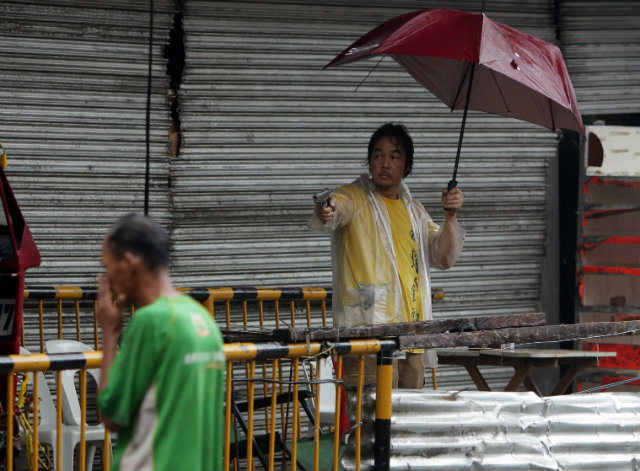SUMMARY
This is AI generated summarization, which may have errors. For context, always refer to the full article.

MANILA, Philippines – Imagine yourself homeless, hungry, and cut off from the rest of the world. Local government is in shambles, and uncertainty fills the air.
It’s the nightmare many survivors of Typhoon Yolanda (Haiyan) live as government, civic, and international aid groups scramble to bring much-needed aid and order in areas devastated by the category 5 storm.
“If there’s food accessible, won’t you get it? If you’re thirsty and there’s water behind a glass, you’ll break the glass,” said Dr Emma Porio, chairperson of the Ateneo de Manila Sociology and Anthropology Department.
Porio spoke about the looting in the Leyte provincial capital of Tacloban. Typhoon survivors began breaking into establishments Sunday, after days of delay in the delivery of food and aid. Gangs have reportedly ransacked businesses, taking television sets and washing machines.
“Sometimes, when people become imbalanced, you do crazy things,” said Porio. A curfew has since been implemented in Tacloban.
The Department of Health (DOH) has since deployed 55 psychologists in Tacloban to help survivors deal with the scars left behind by the storm. “People from Tacloban are not like that. They need psychological counselling,” said DOH Eastern Visayas chief administrator Annabelle de Veyra.
‘No clear rules’
The “looting,” Porio added, was the result of a lack of structure in the city. “In a crowd where there are no clear rules, then you’ll do anything because nobody’s telling you you’re not supposed to do that,” she said.
At this point, Porio said the concept of community has disappeared in the ravaged town. “You really have to struggle to organize them again,” she added. Reports of inmates roaming free in the aftermath of the storm add to the air of uncertainty in the town.
Jail officers recaptured some prisoners who attempted to escape Sunday, November 10.
Interior Secretary Mar Roxas, in an interview with CNN on November 14, said the “entire force of the government” is attending to the situation in Tacloban.
“If we had set aside gallons or places of water, it just turns out that the need is that of a swimming pool so what was a garden hose is now a firetruck hose is now a firetruck’s house and we’re doubling this everyday and this should accelerate as the days go by,” he added.
Explaining government’s strategy in disasters, Roxas said local government units are the first responders, while the national government steps in on “day two or three to support that.”
The problem is, the city’s government officials and first responders themselves were victims. Additional troops from the Philippine police, as well as US marines flew in to help restore order in the city. City officials on Sunday, November 10, urged President Benigno Aquino III to declare a state of emergency in the city – if needed, martial law, to prevent anarchy.
“Natulala rin yung mayor, yung police. In disasters, there should be somebody who should be taking charge,” she said. (Even the mayor was in a daze, even the police.)

The ‘new normal’
If there’s one thing government officials and citizens should learn from the devastation, it’s that the world is changing, and it’s changing fast. “What is the new normal? The new normal is that we really do not know very much,” she said.
Storm surges – up to 16 feet high – is a phenomenon most Filipinos are unfamiliar with. The unfamiliarity, said Porio, also led to a lack of preparedness. Tacloban City officials conducted preemptive evacuations in landslide and flood-prone areas. But on Friday, November 8, storm surges engulfed the entire coastal city.
In the cities of Caloocan, Malabon, Navotas, and Valenzuela, Porio recalled that before, locals underestimated the danger of flooding and leptospirosis. It was only after Typhoon Ondoy that locals understood the sort of danger they posed.
Several calamities in the past, such as Ondoy in Metro Manila and Typhoon Sendong in Mindanao, showed Filipinos the danger of heavy rainfall. Coastal towns in typhoon-prone Visayas are familiar with strong winds. But “the history of storm surges is not there,” she added.
“The sad reality is, there’s no better teacher than experience,” she said.
A world without cellphones
What made coordination efforts close to impossible in the days immediately after the storm hit the Visayas, was the lack of communication lines. Up until Tuesday, November 12, telecom services were limited in the city. The United Nations on Saturday, November 9, sent teams to restore communication in Tacloban and other areas.
It’s a reminder, said Porio, of how dependent we’ve grown on cellphones and even air travel. It was back to the basics for government and the loved ones of those living in the city, who resorted to “social networks” – not just those online.
“You have to go back to how our ninuno [ancestors] worked,” she added.
Reassuring and pacifying those cut off from the rest of the world is also a challenge. Without power and access to media, those in need don’t know if, or when, help is coming. “[The victims feel] desolate and abandoned. You can see that they’re really so out of it. All of these people are in shock, they’re traumatized,” Porio added.
Restoring order in Tacloban, and other towns ravaged by the storm, will be an uphill climb. Aside from restoring government, Porio said typhoon survivors should be given activities that contribute in rebuilding the city such as clearing streets and collecting the dead.
“Give them something to do rather than nakatunganga (doing nothing). Activity is the best way to recover,” she said. – Rappler.com
Add a comment
How does this make you feel?
There are no comments yet. Add your comment to start the conversation.